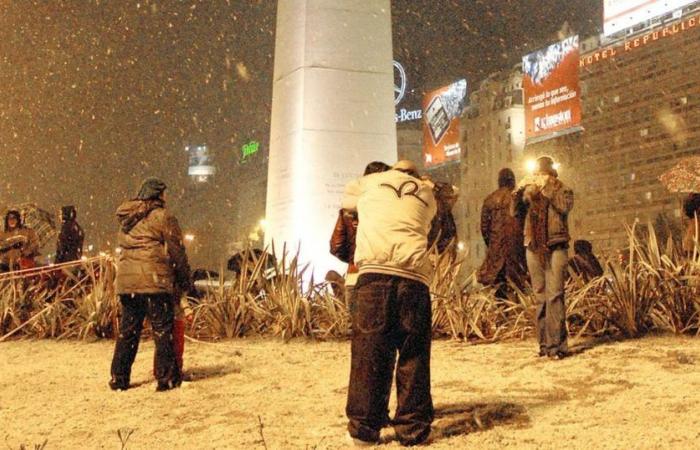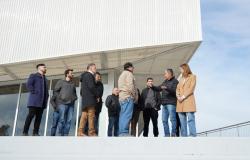The cold that runs through the entire country will seem to worsen this weekend and it is already being analyzed whether the people of Buenos Aires and Buenos Aires, who live in the Buenos Aires Metropolitan Area (AMBA), will be able to see snow fall, as happened in July 2007.
It is that he weather forecast indicates, for Saturday and Sunday, Temperatures around 2 degrees Celsius with overcast skies. Thus, Infobae consulted different meteorologists and climate experts to understand the possibilities of this weather phenomenon happening.
“The temperatures expected this weekend in the AMBA are low, compared to normal, but “They are still very high for a snow episode,” said to Infobae Cindy Fernándezcommunicator of National Meteorological Service (SMN).
For the inhabitants of the metropolitan area to enjoy watching snowflakes fall, several meteorological variables must occur simultaneously: “There have to be certain humidity conditions that are not very common in our area. That is, humidity not only on the surface, but at all levels of the atmosphere. That is not normal for it to happen in the AMBA.”
Furthermore, he clarified that these two conditions, humidity and low temperatures on the surface and in the atmosphere, have to occur simultaneously during an episode of precipitation. However, Fernández explained that “for this weekend, although it will be cold, snow conditions will not occur, the sky will be clear, super sunny, so there will not be any type of cloud that generate snowflakes.”
The SMN spokesperson anticipated that there is “a chance of snow on the southern coast of Buenos Aires, perhaps as far as the Mar del Plata area, between Friday and Saturday”. This is because, in that area, the southern wind, which has maritime origin, is a mass of humid air that when it enters the continent is very cold and also contains humidity.
And he added: “It will generate some showers in the coastal area of southern Buenos Aires. A small ‘shower’ of snow could be generated, but if this phenomenon occurs, it will be in the form of slush or graupel, which is a phenomenon that occurs when water droplets freeze. That is to say, not snow falls from the clouds, but rain, that is, liquid water that, along the way, as it descends, encounters air that is very cold. Then that drop freezes; and it reaches the surface as soft hail balls, like small chickpeas. And that, when it accumulates on the ground, looks white, as if it were snow.”
“But they are not snowflakes, but rather small grains. This phenomenon is called graupel and it is quite common on the Argentine coast,” Fernández concluded.
For his part, the meteorologist Sergio Jalfin raised to Infobae a similar situation: “In the southeast of Buenos Aires, this includes Sierra de la Ventana and Tandil, there is a possibility of sleet or maybe snow. It is for early Saturday morning, during the early hours of the morning and early morning hours. This does not cover the AMBA. In other words, here in the metropolitan area there is no chance of snow.”
At the same time he remarked: “The chance of sleet for the coast is very low, but it exists. And it is low in the Sierra de Tandil and de la Ventana, but an isolated flake can fall at dawn on Saturday.”
On July 9, 2007, Argentina experienced an unusual weather event. Several regions of the country, including towns in the north of the province of Buenos Airesas well as in the south of Santa Fe, Cordova, saint Louisthe north of Mendoza, San Juan, The Rioja and Catamarcaexperienced a historic snowfall. This phenomenon began around 10 in the morning in Hummockaccording to National Metereological Service (SMN).
In the Buenos aires city, the snowfall was officially recorded at 3 p.m., according to the SMN. The temperature dropped rapidly, favoring the accumulation of snow on the streets, with a minimum of 2.6 °C and a wind chill of -1.2 °C (29.8 °F). This descent allowed the rain to turn into solid snow.
The SMN explained that on the morning of that day, temperatures in the City were around 4 °C (39.2 °F), which was initially insufficient to accumulate snow on the ground. However, during the day, the air progressively cooled to allow snowfall.
Days before, a cold front had penetrated from the Patagonia to the center of the country, following an air mass of polar origin that caused extreme minimum temperatures, which reached -8 °C (17.6 °F) in the southwest of Santa Cruz, on July 7. Later, an anticyclone of the Peaceful reinforced these cold currents, culminating in the remarkable snowfall in Buenos Aires.






